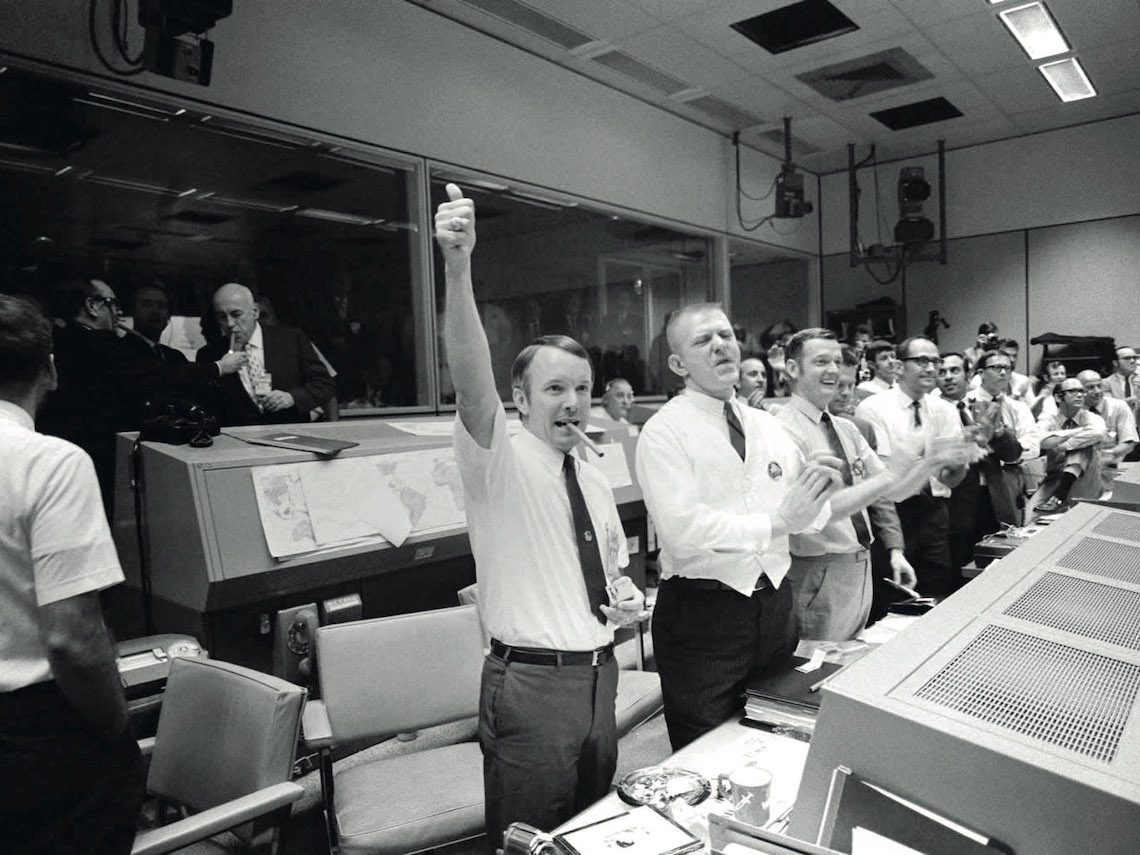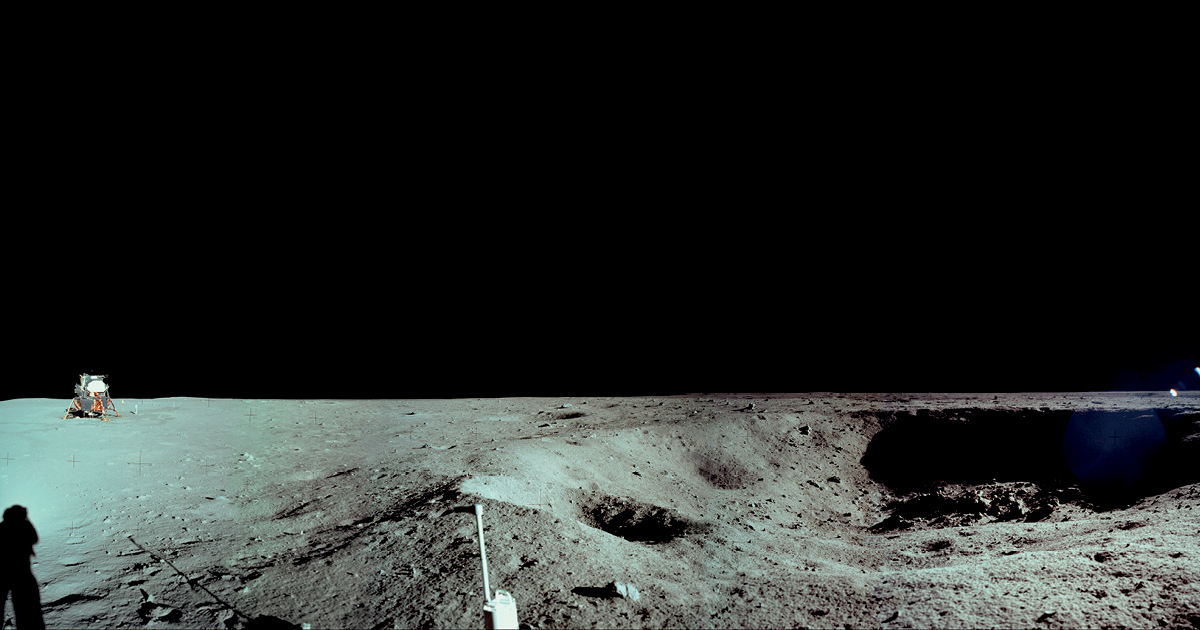Political and military disputes were the driving force behind the scientific and technological advances that took humankind into space, and 50 years ago, to the Moon. On Sunday July 20, 1969, American astronauts Neil Armstrong (1930–2012) and Edwin Aldrin left the Apollo command and service module under the control of Michael Collins and descended aboard the Eagle landing module into the sea of Tranquility, a lunar mare on the visible side of the Moon. The historic feat was watched on television by millions of people worldwide and marked the end of the space race between the USA and the Soviet Union, the two economic and military superpowers of the time.
At the height of the space race, the voyage to the Moon required a substantial investment in the development of new technologies. The mission needed a rocket powerful enough to overcome Earth’s gravity and propel a capsule beyond the planet’s orbit at about 40,000 kilometers per hour. The capsule also had to be sturdy enough and fully prepared to cope with the friction of Earth’s atmosphere on its return and to protect its occupants from the subsequent heat of a few thousand degrees Celsius. From an operational perspective, the team of astronauts—most of whom were former fighter pilots—had to undergo intense physical and emotional training. This is the basis on which the Mercury, Gemini, and Apollo space programs were established in the US, as well as a number of secret programs (including Zond) created by the Soviets. The objective was to prepare astronauts and cosmonauts to withstand the conditions of the voyage, and if necessary, to operate and even repair the spacecraft during flight. Over US$163 billion (in 2008 values) was spent on the Apollo program alone between 1960 and 1972.
The space race actually began a quarter of a century earlier as the result of a fierce political and military feud between the US and the Soviet Union after the end of World War II. Both countries emerged politically and technologically stronger from the war in which they were allies against Germany and the other two Axis countries, Japan and Italy. After Germany surrendered on May 7, 1945, it was agreed at the Potsdam Conference in August that the USA, France, the UK, and the Soviet Union would divide rule of the German territory. The four countries were all seeking their share of the spoils of war, with a particular interest in a German weapon that would later help humans travel into space. That weapon was the V-2 rocket (Vergeltungswaffe Zwei, meaning “Retribution Weapon 2”), a 14-meter-high missile capable of traveling at faster than the speed of sound while carrying one ton of explosives over hundreds of kilometers.
Its creator was the young and talented German engineer Werner von Braun (1912–1977), who would later develop the world’s largest rockets, including those that took men to the Moon. Von Braun and his colleagues began working for the German army in 1932, before Hitler’s rise, and two years later they designed the first rocket-propelled missiles. In 1937, they created the V-2, 6,000 of which were produced in the last two years of the war, largely by prisoners in concentration camps. A quarter of them were launched against England and another quarter against other countries, causing considerable damage. In early 1945, as the Allied armies approached, Von Braun realized that the war was lost and surrendered to the Americans, along with the technical documents on the missiles.
“World War II changed everything in the field of rocket development,” writes Roger D. Launius, NASA’s chief historian from 1990 to 2002, in the book The Smithsonian History of Space Exploration, 2018. “Prior to the conflict, progress in rocketry had been erratic, but the looming war served to highlight the military potential of the technology.”
After Germany was defeated, US intelligence officials quickly began Operation Paperclip, the aim of which was to bring highly skilled German scientists and technicians to the US, including some of Von Braun’s team. In September, a month after the US dropped atomic bombs on Hiroshima and Nagasaki in Japan, Von Braun and nearly 120 colleagues helped the Americans reassemble and test the V-2s taken from Germany. The Germans were later given American citizenship and began designing more advanced and long-range missiles, such as the Redstone, which was later used in training by the first astronauts.

NASA
Apollo 13 Flight Directors Gerald Griffin, Eugene Kranz, and Glynn Lunney (front row, from left) celebrate the astronauts landing safely back on EarthNASAThe beginning of the space race
Despite occupying East Germany where the V-2 factories were located, the Soviets were slower to act. In his book, Launius reports that shortly after the war ended, Soviet leader Josef Stalin (1878–1953) sent a team led by Sergei Korolev (1907–1966) to occupied Germany to interview engineers and technicians who had helped develop the V-2 that had not been captured by other allied forces. The Soviets recovered enough material to rebuild 12 missiles, and in October 1946, they took about 200 Germans who had worked on V-2 production back to the Soviet Union. In October the following year, the Soviets tested their first missile.
In terms of destructive power at a distance, the USA was ahead of the Soviet Union, which only tested its first atomic bomb in 1949. The Soviet A-bomb was heavier and required the use of airplanes, ships, or submarines to reach the USA, which by then had become its main adversary. As relations between the former allies deteriorated, Stalin created a long-range missile development program run by Korolev, a skilled engineer and manager. Based on the V-2, the Soviets designed increasingly powerful missiles until they reached the R-7, the first intercontinental ballistic missile. The R-7 was capable of reaching the USA, but there were only a few locations from which it could be launched.
As the United States began using missiles for research into the Sun’s effects on Earth, as well as planning to launch a satellite capable of collecting geophysical data and initiating programs to take humans into space, Korolev saw a unique propaganda opportunity. He convinced Nikita Krushev (1894–1971), Stalin’s successor, to replace the explosive material in an R-7 rocket with a simple satellite and launch it into space. On October 4, 1957, Sputnik 1 was launched. It was the first artificial object to orbit Earth—the 84-kilogram spherical satellite emitted a beep traceable worldwide by radio operators. “The achievement had a significant symbolic impact,” explains mechanical engineer José Bezerra Pessoa Filho, a retired researcher from the Brazilian Aeronautics and Space Institute (IAE) in São José dos Campos and an expert in the history and politics of the space race. “It showed the USA that the Soviet Union had the power to hit them with a nuclear weapon within half an hour if it wanted.”
A month after Sputnik, the Soviets launched another rocket, this time with a dog called Laika on board: the first living creature in space. They had scored a second goal before the USA could even put its first satellite (Explorer 1) into orbit in January 1958.



